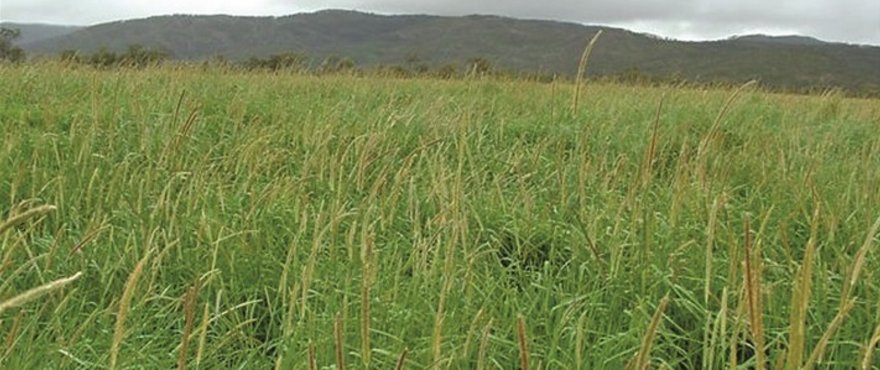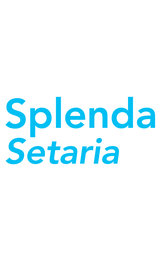Download a copy of the Setaria Splenda factsheet.
Splenda was bred by the CSIRO, Division of Tropical Crops and Pastures in Queensland, Australia. The variety arises from controlled pollination between the botanical varieties of Splendida and Sericea grown for several generations to stabilise the species. Splenda combines the high vegetative yield of Splendida, which was sterile seed, with seed production and fertility approaching that of cv. Kazungula. Splenda is a robust perennial leafy forage grass with broad leaves to approximately 14mm wide and flowering at about 2 metres. Its stems are thicker and broader than Kazungula, has more nodes and leaves per stem and flowers later in the season. The young growth of Splenda is leafy and tillers are broad and strongly flattened, the leaf sheaths often overlapping in a fan shape and mostly reddened towards the base. Splenda is adapted to the relatively high rainfall tropics and subtropics of 800mm or more with a maximum dry period not greater than 12 weeks. Suited to most soil types and is very tolerant of waterlogging. Splenda combines with most of the taller growing legumes of the tropics. Frost tolerance is similar to Kazungula as light frosts kill the leaves. Splenda can be used for permanent pasture, hay, silage, cut and carry, soil conservation & hedgerow.
Key features
- Hardy, high yielding and later maturing variety
- Suited to sub tropical regions
- Very palatable. (May be heavily grazed without risk of plant death)
- Relatively frost tolerant and withstands water logging
Establishment
It can be sown successfully from spring to early autumn. As a general rule, it is best to choose a suitable sowing time for any associated legume. Can be planted in wider rows, allowed to grow tall, and rolled flat to facilitate nodal rooting and sward formation.
Agronomy and management
Splenda is very palatable to stock and the stems are readily grazed up to and after flowering. After grazing, stem nodes may sprout aerial tillers, and these may root and establish if the stems are trampled into the soil. Splenda may be heavily grazed without the risk of plant death. Although it is fairly tolerant of mowing or grazing, it will give way to creeping grasses such as blue couch or mat grass if grazed heavily over a prolonged period so requires controlled management to achieve optimum results. Setaria decline is more rapid if nitrogen fertility is low. For best combination of regrowth and quality, particularly in dairying systems, plants should be cut at 30–45 cm at least every 30 days. Maximum regrowth was measured in the Philippines cutting at 45 cm every 60 days.
Performance
Annual yields of 4 to about 24 t/ha DM, depending on fertility and moisture. In the Philippines dry matter production per hectare in excess of 18,000 kg has been recorded and assessed as one the top producing grass species. In Vanuatu an established sward grew to 2m in 3 months with a regrowth of 1m in 1 month. Protein content of the grass depends on nitrogen fertility of the soil, and age of regrowth of the stand (best if less than 4 weeks’ regrowth). Young leafy regrowth (3 weeks) can have digestible dry matter levels of 70%, but after 6 – 8 weeks, digestibility levels drop to 50 – 55%. Sodium levels are often low requiring supplementation in the diet.
Animal production
Well eaten by all classes of livestock, but should not be fed to horses. In the subtropics, steers continuously grazing setaria fertilised with 330 kg/ha N, and stocked at about 3 steers per hectare, can produce live weight gains of 500–800 kg/ha per year.
Toxicity
Oxalate concentration is high with levels from 4.5–6.7% of DM in 3-week regrowth. Such high levels can cause ‘big head’ disease’ (Osteodystrophia fibrosa) in horses and ‘milk fever’ (Hypocalcaemia) caused by a shortage of calcium in the blood. It can be treated with an injection of calcium borogluconate solution. Cattle introduced gradually to, and maintained on setaria develop a rumen flora that can detoxify the oxalate. ‘Grass staggers’ (Hypomagnesaemia) can also occur in animals grazing Setaria sphacelata var. splendida, a disease caused by too little magnesium in the blood system, induced through low levels of Mg and high levels of K in the feed. In dairy cows, one is often a complication of the other. It is therefore wise to use a combined treatment of calcium borogluconate and magnesium hypophosphite.
Pest / disease resistance
Severe attack by armyworm and pasture webworm can destroy much of the leaf, particularly young leaf. Buffel grass seed caterpillar can cause considerable damage to seed crops from late January onwards. Pyricularia leaf spot is prevalent under hot humid conditions and can retard the growth of ungrazed stands.
Suggested sowing rates
Recommended planting rates for AgriCOTE Splenda are: Marginal dryland: 2 – 6kg per hectare Good dryland: 8 – 12kg per hectare Irrigated: 12 – 15kg per hectare
Disclaimer: The information presented in this brochure is from official and other sources and is considered to be reliable. It is provided in good faith and every care has been taken to ensure its accuracy. Barenbrug does not accept any responsibility for the consequences that may arise from the acceptance of recommendations or the suggestions made.



